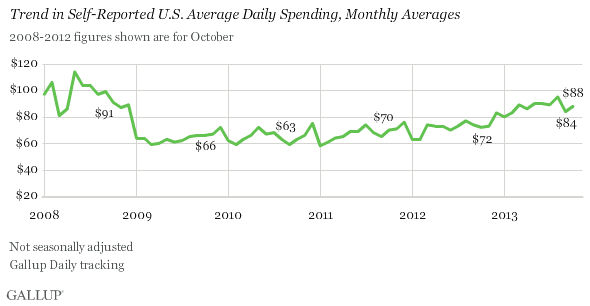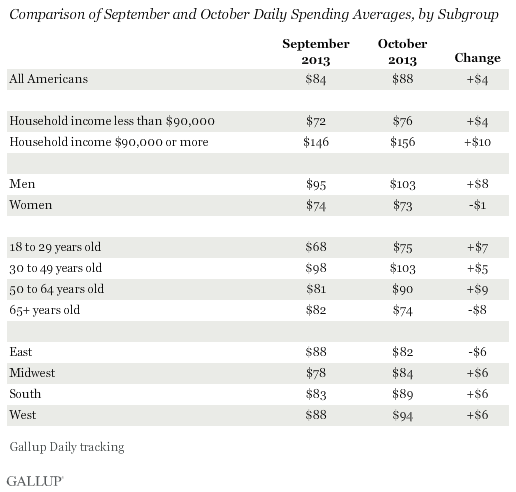WASHINGTON, D.C. -- Americans' self-reported daily spending averaged $88 in October, up slightly from $84 in September but still below the $95 from August -- the highest average in any month in five years. Americans' average daily spending exceeds the $72 found in the same month last year and is the highest for any October since 2008.

Gallup asks Americans on its Daily tracking survey to report how much they spent the prior day, excluding household bills and major purchases like a car or home. The data give an estimate of discretionary spending.
Gallup's spending measure has generally been trending upward so far in 2013, with a monthly average of $88, up from the $72 monthly average for all of 2012.
Although partisan bickering in Washington about the recent shutdown and the debt ceiling limit negatively affected Americans' economic confidence, Gallup found that it does not seem to have influenced their holiday spending plans. Still, the plunge in economic confidence that took place during the government shutdown could negatively affect spending levels in the near future.
October Spending Strong Among Most Subgroups
Upper-income Americans' self-reported spending increased by an average of $10 in October, suggesting that fiscal debates in Washington did not deter them from spending. In fact, spending increased at least slightly across most subgroups.

Bottom Line
Trends in consumer spending can serve as an indicator of future economic growth in the U.S. Personal consumption expenditures account for roughly 70% of GDP, and with self-reported spending trending upward thus far in 2013, continuing modest growth is possible. The Conference Board has forecasted U.S. GDP growth of 1.7% for the fourth quarter of 2013.
However, Americans' standard of living perceptions have declined and economic confidence remains deeply negative. As job reports continue to fall short of expectations and uncertainty about the debt limit and the federal budget persist, it is possible that consumer spending will decline in the coming months. Americans' soured optimism has yet to affect spending, but lag effects are still a concern.
Gallup.com reports results from these indexes in daily, weekly, and monthly averages and in Gallup.com stories. Complete trend data are always available to view and export in the following charts:
Daily: Employment, Economic Confidence, Job Creation, Consumer Spending
Weekly: Employment, Economic Confidence, Job Creation, Consumer Spending
Read more about Gallup's economic measures.
View our economic release schedule.
Survey Methods
Results for this Gallup poll are based on telephone interviews conducted Oct. 1-30, 2013, on the Gallup Daily tracking survey, with a random sample of 15,438 adults, aged 18 and older, living in all 50 U.S. states and the District of Columbia.
For results based on the total sample of national adults, one can say with 95% confidence that the margin of sampling error is ±1 percentage point.
Interviews are conducted with respondents on landline telephones and cellular phones, with interviews conducted in Spanish for respondents who are primarily Spanish-speaking. Each sample of national adults includes a minimum quota of 50% cellphone respondents and 50% landline respondents, with additional minimum quotas by region. Landline and cell telephone numbers are selected using random-digit-dial methods. Landline respondents are chosen at random within each household on the basis of which member had the most recent birthday.
Samples are weighted to correct for unequal selection probability, nonresponse, and double coverage of landline and cell users in the two sampling frames. They are also weighted to match the national demographics of gender, age, race, Hispanic ethnicity, education, region, population density, and phone status (cellphone only/landline only/both, and cellphone mostly). Demographic weighting targets are based on the March 2012 Current Population Survey figures for the aged 18 and older U.S. population. Phone status targets are based on the July-December 2011 National Health Interview Survey. Population density targets are based on the 2010 census. All reported margins of sampling error include the computed design effects for weighting.
In addition to sampling error, question wording and practical difficulties in conducting surveys can introduce error or bias into the findings of public opinion polls.
For more details on Gallup's polling methodology, visit www.gallup.com.
